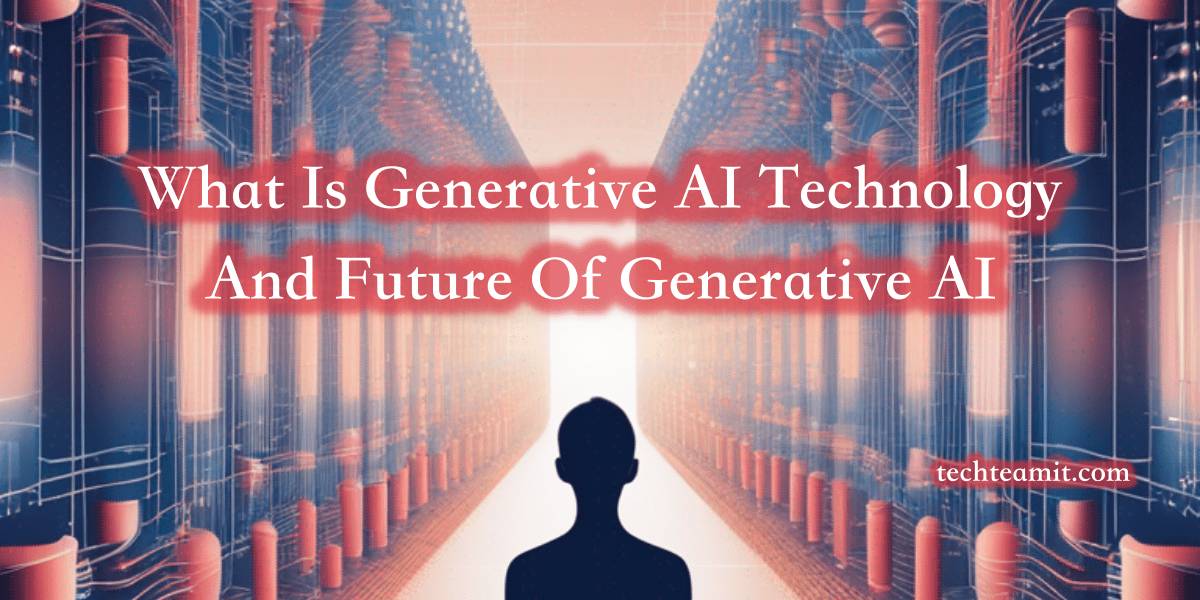What is generative AI technology and why is it suddenly everywhere? Even cloud providers like Google Cloud GCP and Amazon Cloud AWS are using these technologies to solve some of their customer problems, enhance existing products, and even build new products.
So, what is generative AI, and future of generative AI. How GenAI is different from the AI technology we have been using for some time now?
We have used traditional AI systems that are trained and designed to recognize patterns and make predictions based on the available data. The data may be collected from different sources it is given to the AI system. Based on the models and logic given AI will consume a large amount of data and identify the patterns or behaviors. Based on this AI will predict the actions in the future.
What Is Generative AI?
Let’s define generative AI – generative AI creates new content in the form of images, text, audio, and more from the same data you have been using for your traditional AI system. Gen AI can directly read data from multiple data sources in real-time and generate models, images, and audio.
Generative AI can create a synthetic data set and this can be used further by businesses for customer communication, training, and more. This will also help businesses to protect the privacy of the original data.
Now, to achieve all this generative AI uses large ML models that are already trained on large/big amounts of data.
With the help of GAN’s (generative adversarial networks) a type of deep learning, generative A creates new content. A GAN uses a generator that creates new data and a discriminator that evaluates the newly created data.
The generator and discriminator both work together. Based on the inputs received from the discriminator, the generates keeps working and finally generates content that is very similar to the real data/output expected.
With new developments in deep learning, new AI can take complicated inputs, like videos or images, and answer in simple outputs, for example, if the image contains a dog or not.
Let’s look at some of the examples of Generative AI
Text Using Generative AI:
- Very easy to understand use case, with the help of generative AI we can translate text from one language to another.
- In the second use case, we can use generative AI to write news articles and even scripts. These generative AI news are as good as human generated content.
Images Using Generative AI:
- Generative AI using existing information like a person’s picture or existing scene can create new portraits or generative AI landscape.
- We can describe the image in text format and it can generate image-based of the text inputs. There are many free SAS-based generative AI image creation platforms used by people online.
Audio Using Generative AI:
- Using advanced AI algorithms and deep learning methods, generative AI can create new music tracks, clone the voice of the person, and give sound effects.
Video Credit Google Cloud Tech
Generative AI Market – Future of Generative AI
How Generative AI is used in real life and what is the change it is bringing?
Generative AI has the potential to bring change in industries like:
GenAI In Advertising:
Now based on your existing advertisements and new data inputs combining Generative AI can create new advertisements. This entire process will help to speed up the new advertisement creation process and will also help customers reach faster to their customers. New advertisements will also help to attract a new audience.
GenAI In Art and Design:
With the help of Generative AI artists can create new ideas and concepts. In the life of artists or designers creating multiple options using ideas and concepts takes time.
Now Generative AI can help to reduce time generating new ideas and concepts which will help customers to get the best generative AI model options before final work.
GenAI In Entertainment:
Content creation is another time-consuming process and also needs a lot of technology nowadays. Generative AI can help in creating new movies, video games, and even TV shows.
This will help content creators to speed up the entire process of production and help to reach new audiences faster.
Most of the OEMs are hosting these SAS-based applications using public cloud providers like GCP and AWS. These applications can take the advantages offered by the public cloud such as multi-region deployment monitoring and scale.
Online Education:
In the online education content creation process, people are using Generative AI to create models to explain the fundamentals to students. This can use generative AI video and audio for content creation.
These are some of the examples of the generative AI market, there are sectors such as health care and architecture where generative AI has been used in multiple use cases.
Does Generative AI have the potential to disrupt several industries?
Many of us have concerns that generative AI can potentially disrupt several industries. It’s a valid concern. The growing use of generative AI technology in many industries/sectors will lead to job displacement.
In industries such as manufacturing and customer service, we have seen the good use of generative AI, which can replace the tasks that are done by humans easily.
On the other side, we have also seen the many potential benefits that could bring good change in customer experience and the economy.
By taking out repetitive tasks, which also consume a lot of time GenAI can free up time for humans. This time we can utilize it to do more creative work where humans’ creative and emotional aspects are needed.
How does Generative AI work?
A lot of things run behind the scenes. There are core algorithms and frameworks that are used during the process of creating creative output.
Generative Adversarial Networks (GANs)
Generative AI learns from the data, it can do it on its own (unsupervised) or it can be a guided learning (semi-supervised) and it will train itself. The generator learns how to make new data that is similar to the original data.
It can do it by connecting to different sources of data in real-time. Now based on this, using patterns to make new data that is realistic. To do this generative AI uses some of the core algorithms and frameworks Generative Adversarial Networks (GANs) and Discriminator.
Diffusion Models:
In this framework, while learning about the data, GenAI levels behind traces, that are later used during the process of generating new data.
There are three important parts diffusion model.
- Text encoder model
- UNet noise predictor model
- Autoencoder-decoder model
All these components work together and create a detailed image form data which is used to learn.
Benefits of Generative AI
There are several benefits Generative AI offers, and these can positively impact lives.
1. Increased Efficiency
Generative AI can do things faster than humans. For example, GenAI can create content faster.
It can do well when it comes to doing it from available data. It can design graphics faster from large data. It can design graphics and ideas faster.
2. Boosted Creativity
Generative AI is trained on large amounts of data from various sources, so it is capable of producing creative ideas/content faster. People like artists and creators can take advantage of Generative AI to have more creative options/ideas.
3. Help In Decision-Making
One of the key benefits of Generative AI Technology is, to help in the entire decision-making process. Business owners can use AI models to come up with new and innovative marketing strategies or new design options.
FAQ: What Is Generative AI Technology
Is GPT a generative AI?
Yes, GPT (Generative Pre-trained Transformers) part of neural network models powers Generative AI applications such as ChatGPT.
What does GPT stand for?
GPT – stands for Generative Pre-training Transformer
Business Applications of Generative AI (Examples)
Let’s look at some of the common applications of generative AI by Organizations to enhance productivity and add value to services and products.
Virtual Assistants
Companies are using VA to enhance customer experience with human-like responses so that problems/queries can be solved using data.
Content Generation
Using synthetic data, companies are generating text and images for internal training and customer interaction.
Design And Creativity
As an organization, you can use Gen AI to get suggestions and generate new prototypes/designs. This is also helpful in the entire innovation process and can save a lot of time.
Creating Personalization
Gen AI can help you with tailored content and personalized recommendations for your presentations.
Conclusion
In the coming days, I am expecting to see more innovative use of generative AI in different fields. Generative artificial intelligence is a powerful technology and has the potential to bring change in several industries.
The way Generative AI technology generates new content from existing data, it is very interesting to see how it will change the way we create and consume content in the coming days. So, the future of Generative AI technology is promising.

